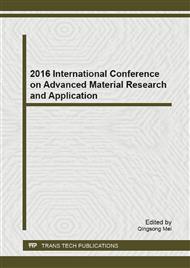[1]
Speight, J. G. The Chemistry and Technology of Petroleum. Dekker, New York, (1991).
Google Scholar
[2]
P. G. Moses, B. Hinnemann, H. Topsøe, J. K. Nørskov, The hydrogenation and direct desulfurization reaction pathway in thiophene hydrodesulfurization over MoS2 catalysts at realistic conditions: A density functional study, J. Catal. 248 (2007).
DOI: 10.1016/j.jcat.2008.09.008
Google Scholar
[3]
P. G. Moses, B. Hinnemann, H. Topsøe, J. K. Nørskov, The effect of Co-promotion on MoS2 catalysts for hydrodesulfurization of thiophene: A density functional study, J. Catal. 268 (2009) 201-208.
DOI: 10.1016/j.jcat.2009.09.016
Google Scholar
[4]
P Liu,. J. Rodriguez, A. T. Asakura, J. Gomes, K. Nakamura, Desulfurization reactions on Ni2P(001) and alpha-Mo2C(001) surfaces: Complex role of P and C sites, J. Phys. Chem. B 109 (2005) 4575-4583.
DOI: 10.1021/jp044301x
Google Scholar
[5]
Y. Li, W. Y. Guo, H. Y. Zhu, L. M. Zhao, M. Li, S. R. Li, D. L. Fu, X. Lu, H. H. Shan, Initial Hydrogenations of Pyridine on MoP(001): A Density Functional Study, Langmuir 28 (2012) 3129-3137.
DOI: 10.1021/la2051004
Google Scholar
[6]
Z. G. Deng, Y. Q. Lei, X. Q. Lu, W. L. Wang, H. Y. Zhu, S. -P. Ng, W. Y. Guo, C. -M. L. Wu, Hydrodenitrogenation of pyridine on MoP(010): Competition between hydrogenation and denitrification, Inorg. Chim. Acta 435 (2015) 30-37.
DOI: 10.1016/j.ica.2015.06.008
Google Scholar
[7]
Z. L. Wu, F. X. Sun, W. C. Wu, Z. C. Feng, C. H. Liang, Z. B. Wei, C. Li, On the surface sites of MoP/SiO2 catalyst under sulfiding conditions: IR spectroscopy and catalytic reactivity studies, J. Catal. 222 (2004) 41-52.
DOI: 10.1016/j.jcat.2003.10.019
Google Scholar
[8]
J. Ren, C. -F. Hio, X. -D. Wen, Z. Cao, J. G. Wang, Y. -W. Li, H. J. Jiao, Thiophene Adsorption and Activation on MoP(001), γ-Mo2N(100), and Ni2P(001): Density Functional Theory Studies, J. Phys. Chem. B 110 (2006) 22563-22569.
DOI: 10.1021/jp0640474
Google Scholar
[9]
P. Liu, J. A. R., and J. T. Muckerman. Desulfurization of SO2 and Thiophene on Surfaces and Nanoparticles of Molybdenum Carbide: Unexpected Ligand and Steric Effects, J. Phys. Chem. B 108 (2004) 15662-15670.
DOI: 10.1021/jp040267a
Google Scholar
[10]
H. Luo, J. Cai, X. Tao, M. Tan, First-principles study of H2S adsorption and dissociation on Mo(110), Comput. Mater. Sci. 101 (2015) 47-55.
DOI: 10.1016/j.commatsci.2015.01.003
Google Scholar
[11]
Z. Jiang, P. Qin, T. Fang, Investigation on adsorption and decomposition of H2S on Pd(100) surface: A DFT study, Surf. Sci. 632 (2015) 195-200.
DOI: 10.1016/j.susc.2014.07.020
Google Scholar
[12]
Z. Jiang, M. Li, P. Qin, T. Fang, Insight into the adsorption and decomposition mechanism of H2S on clean and S-covered Au(100) surface: A theoretical study, Appl. Surf. Sci. 311 (2014) 40-46.
DOI: 10.1016/j.apsusc.2014.04.197
Google Scholar
[13]
D. R. Alfonso, First-principles studies of H2S adsorption and dissociation on metal surfaces, Surf. Sci. 602 (2008) 2758-2768.
DOI: 10.1016/j.susc.2008.07.001
Google Scholar
[14]
D. R. Alfonso, A. V. Cugini, D. C. Sorescu, Adsorption and decomposition of H2S on Pd(111) surface: a first-principles study, Catal. Today 99 (2005) 315-322.
DOI: 10.1016/j.cattod.2004.10.006
Google Scholar
[15]
B. Delley, An all-electron numerical method for solving the local density functional for polyatomic molecules, J. chem. Phys. 92 (1990) 508-517.
DOI: 10.1063/1.458452
Google Scholar
[16]
B. Delley, Hardness conserving semilocal pseudopotentials, Phys. Rev. B 13 (1976) 5188-5192.
Google Scholar
[17]
J. P. Perdew, W. Yue, Accurate and simple density functional for the electronic exchange energy: Generalized gradient approximation, Phys. Rev. B 33 (1986) 8800-8802.
DOI: 10.1103/physrevb.33.8800
Google Scholar
[18]
J. P. Perdew, K. A. Jackson, M. R. Pederson, D. J. Singh, C. Fiolhais, Atoms, molecules, solids, and surfaces: Applications of the generalized gradient approximation for exchange and correlation, Phys. Rev. B 46 (1992) 6671-6687.
DOI: 10.1103/physrevb.46.6671
Google Scholar
[19]
J. Song, X. Niu, L. Ling, B. Wang, A density functional theory study on the interaction mechanism between H2S and the α-Fe2O3(0001) surface, Fuel Process. Technol. 115 (2013) 26-33.
DOI: 10.1016/j.fuproc.2013.04.003
Google Scholar
[20]
T. L. Halgren , W. N. Lipscomb, The synchronous-transit method for determining reaction pathways and locating molecular transition states, Chem. Phys. Lett. 49 (1977) 225-232.
DOI: 10.1016/0009-2614(77)80574-5
Google Scholar
[21]
H. Y. Zhu, W. Y. Guo, R. B. Jiang, L. M. Zhao, X. Q. Lu, M. Li, D. L. Fu, H. H. Shan, Decomposition of methanthiol on Pt(111): a density functional investigation, Langmuir, 26 (2010) 12017-25.
DOI: 10.1021/la101678d
Google Scholar


